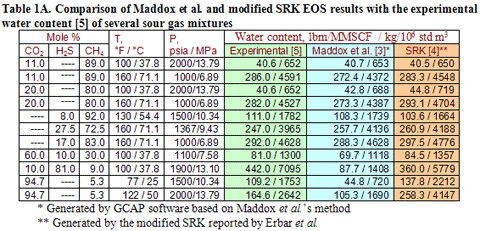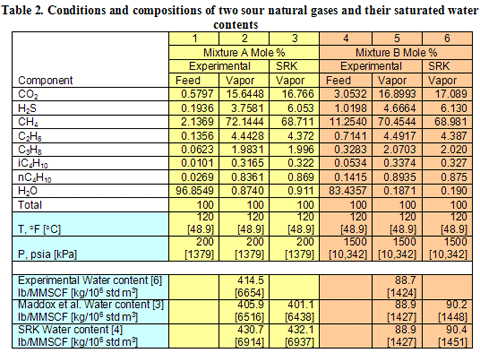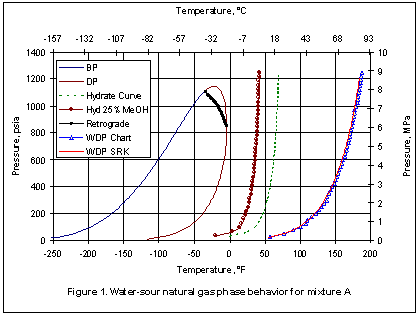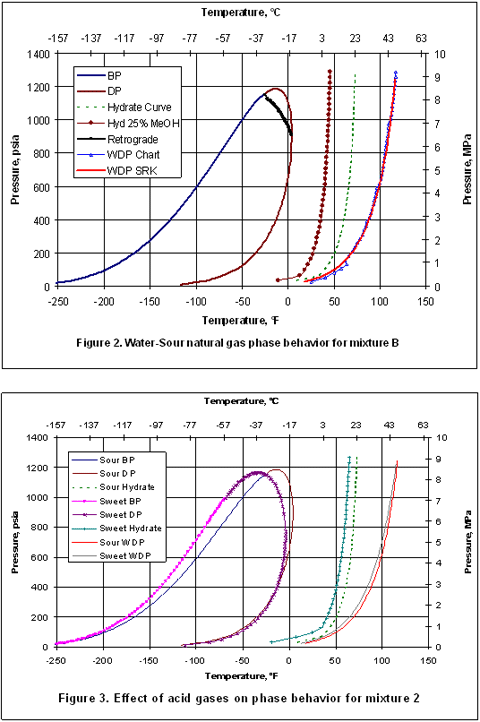In the last Tip of the Month, we discussed the phase behavior of water-sweet natural gas mixtures. In this tip, we will demonstrate the water-sour natural gas phase behavior. In a future tip, we will address water content of acid gases.
Water is produced with oil and gas. A question that comes to mind is: “Why is water important?” The presence of water may cause corrosion, freezing and hydrate formation. All of these problems are enhanced by the presence of acid gases such as H2S and CO2.
A phase envelope with hydrate and water dew point curves is an excellent tool to find out what form/phase water is in at operating conditions, during start-up, during shut-down and during upsets. The water content of a gas depends on the system temperature, pressure and composition of the water containing gas. There are several methods of calculating of water content of sour gases. The details of these methods can be found in Chapter 6 of Volume 1 [1] and Chapter 9 of Volume 3 [2] of “Gas Conditioning and Processing”. In this work we will use Maddox et al. [3] (Figures 6.1, 2, 3 and Equation 6.2 of Volume 1) and the modified Soave-Redlich-Kwong (SRK EoS) reported in GPA RR-42 by Erbar et al. [4]. This version of SRK is tailor-fitted to handle water-hydrocarbon systems containing hydrogen sulfide and carbon dioxide.
The compositions of several sour gases studied in this study along with their measured and predicted water contents are shown in Table 1. The Maddox et al. (referred to as Chart) results were generated using GCAP software and the modified SRK EOS results were generated by performing rigorous three-phase (gas-liquid hydrocarbons-aqueous) flash calculations. A trial version of GCAP can be downloaded here, at the bottom of the page.
Table 1 indicates that as long as the total acid gas concentrations is less than 60 mole percent, Maddox et al. and the modified SRK methods produce results within the accuracy of experimental data. However, for higher concentrations of acid gases, the modified SRK provides a better prediction. The water content of acid gas systems will be discussed further in the next Tip of the Month.
The composition, experimental, and predicted water content by Maddox et al. and the modified SRK for two natural gas mixtures are presented in Table 2. The upper part of columns 1, 2, 4, 5 report the measured mole percent. Based on the feed compositions shown in columns 1 and 4, three-phase flash calculations using the modified SRK were performed and the resulting vapor stream compositions are shown in columns 3 and 6, respectively. Notice that the measured and predicted vapor compositions are not identical. Inaccuracies in predicting the vapor composition can result in errors in predicting the water saturation.
For each vapor stream, the saturated water content was predicted by both methods and is presented in the lower portion of this table. As can be seen from this table, both methods predict saturated water content reasonably well. Not surprisingly, the accuracy of both methods is improved slightly when the experimental vapor composition is used rather than the predicted vapor composition.
Figure 1 represents the phase behavior for mixture A. This figure includes from right to left: the water dew point, hydrate formation, 25 weight percent methanol (MeOH) inhibited hydrate formation, hydrocarbon dew point, retrograde, and the bubble point curves, respectively. The blue-triangular-symbol water dew point curve is predicted by use of Figures 6.1, 6.22 and 6.3 with Equation 6.2 of Volume 1 (Maddox et al. method). The red curve represents the water dew point predicted by rigorous calculations using the modified SRK. It is interesting to see that both methods agree quite well with each other. The region to the right of the water dew point curve is gas phase and to the left, liquid water is present.
Figure 2 presents the phase behavior of sour gas mixture B. With exception of low pressure region, both methods agree quite well.
Figure 3 demonstrates the effect of acid gases on phase behavior of mixture B. As shown in this figure, the presence of acid gases shifts all of the curves to the right. In other words, the presence of acid gases increases the hydrate formation temperature considerably. It also increases the water dew point temperature. It should be noted that the water dew point curves have been generated for a fixed amount of water content predicted at specified separator condition. In this case the separator temperature and pressure were 120 °F [48.9 °C] and 1500 psia [10,342 kPa], respectively.
To learn more about similar cases and how to minimize operational problems, we suggest attending our G4 (Gas Conditioning and Processing), G5 (Gas Conditioning and Processing – Special) and RF-61 Refinery Gas Treating, Sour Water, Sulfur and Tail Gas courses.
Dr. Mahmood Moshfeghian
Reference:
- Campbell, J.M., “Gas Conditioning and Processing, Vol 1: The Basic Principles”, 8th Edition, Edited by R.A. Hubbard, John M. Campbell & Company, Norman, USA, 2001.
- Maddox, R.N., L.L. Lilly, “Gas conditioning and Processing, Vol 3: Computer Applications and Production/Processing Facilities”, John M. Campbell & Company, Norman, USA, 1982.
- Maddox, R.N., L.L. Lilly, M. Moshfeghian, and E. Elizondo, “Estimating Water Content of Sour Natural Gas Mixtures”, Laurance Reid Gas Conditioning Conference, Norman, OK, Mar., 1988.
- Erbar, J.H., A.K. Jagota, S. Muthswamy, and M. Moshfeghian, “Predicting Synthetic Gas and Natural Gas Thermodynamic Properties Using a Modified Soave Redlich-Kwong Equation of State,” Gas Processor Research Report, GPA RR-42, Tulsa, USA, 1980.
- Huang, S.S.-S., A.-D. Leu, H.-J. Ng, and D.B. Robinson, “The Phase Behavior of Two Mixtures of Methane, Carbon Dioxide, Hydrogen Sulfide, and Water” luid Phase Equil. 19, 21-32, 1985.
- Ng, H.-J., C.-J. Chen, and H. Schroeder, “Water Content of Natural Gas Systems Containing Acid Gas”, Research Report RR-174, Gas Processors Association, Tulsa, OK, 2001.





[…] M., ”Water-Sour Natural Gas Phase Behavior,” http://www.jmcampbell.com/tip-of-the-month/2007/11/water-sour-natural-gas-phase-behavior/, […]
[…] the November 2007 Tip of the Month (TOTM), we discussed the phase behavior of water-saturated sour gases. Using limited experimental […]
[…] sweet, sour natural gases and acid gases–water systems. Specifically, in the November 2007 [1], February 2014 [2], and September 2014 [3] Tips of the Month (TOTM), we discussed the phase behavior of […]